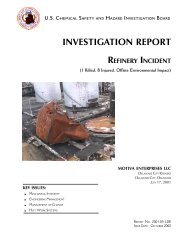CTA Report, Draft 1, ISP Review - US Chemical Safety and Hazard ...
CTA Report, Draft 1, ISP Review - US Chemical Safety and Hazard ...
CTA Report, Draft 1, ISP Review - US Chemical Safety and Hazard ...
You also want an ePaper? Increase the reach of your titles
YUMPU automatically turns print PDFs into web optimized ePapers that Google loves.
There were indications that the oven 405 burner was operating at a natural gas pressure below the<br />
manufacturer’s minimum recommended level. The <strong>CTA</strong> plant was running the burner (Eclipse) at a<br />
maximum natural gas pressure of 11 inches of water column—which is below the minimum rate of 14 for<br />
this burner model. In addition, the burner’s fixed gas butterfly valve was set at 80 to 90 percent closed to<br />
reduce gas input. Recorded flow rates indicate that the burner, with a maximum output rating of 5.5<br />
million Btu/hr (at a maximum gas pressure of 2 psi at the proportionator inlet), was being operated at only<br />
210,000 Btu/hr.<br />
All timers on the burner control panel were found at their minimum settings—contradictory to the<br />
National Fuel Code, which requires a timed purge cycle prior to burner ignition.<br />
The audible alarm mounted on the cabinet door of the burner control box (presumably for alerting<br />
operating personnel of conditions such as flameouts) was not electrically connected. Particulate matter<br />
was observed on the electronic components <strong>and</strong> the cabinet lip, where the door engages the cabinet. The<br />
amount of particulate matter indicated that the cabinet was open frequently during operation.<br />
The high gas pressure cutoff switch was set too high to control an over-gas pressure situation. This<br />
setting allowed the feeding of excessive amounts of gas into the burner if a high-pressure situation<br />
occurred, such as failure of the pressure regulator.<br />
The main gas line primary or safety valve (2-inch flanged, North American) was found with a loose<br />
actuator cover <strong>and</strong> showed debris accumulation on the upper mechanical parts (see Figure C-1). This<br />
dust, fiberglass, <strong>and</strong> oil contributed to the valve’s failure to adequately close, thereby creating an internal<br />
leak in the gas line. During down time or “burner-off” conditions, the safety valve may have been leaking<br />
natural gas through to the gas vent line at the rate of 7.5 L/min.<br />
In the “burner-on” condition with the gas control valves open <strong>and</strong> the normally open solenoid gas bleed<br />
valve closed, there was still a 0.7 L/min leak-through to the vent system from the bleed valve itself.<br />
114









